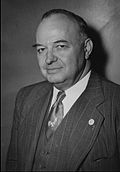| |||||||||||||||||
| |||||||||||||||||
 County results (regular election) Clements: 50–60% 60–70% 70–80% 80–90% Dawson: 50–60% 60–70% 70–80% 80–90% | |||||||||||||||||
| |||||||||||||||||
| Elections in Kentucky |
|---|
 |
Two United States Senate elections for the Class 3 U.S. Senate seat from Kentucky were held simultaneously on November 7, 1950.
Contents
- Primary elections
- Democratic primary
- Republican primary
- General election
- Candidates 3
- Results 3
- Special election
- Results 4
- See also
- References
- Bibliography
After Senator Alben Barkley resigned on January 19, 1949, to become Vice President of the United States, Governor Earle Clements appointed Garrett L. Withers to fill the vacant seat until a successor could be duly elected to complete the expired term. The special election was scheduled for November 7, 1950, concurrent with the regular election to the next term. Clements appointed Withers with the intention of running for the seat himself, which he did, defeating Republican former judge Charles I. Dawson in both elections.



